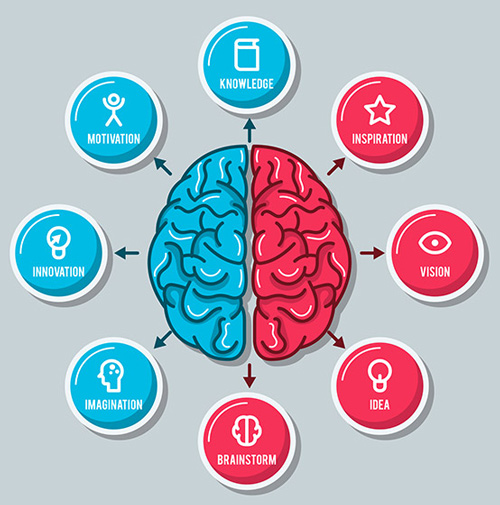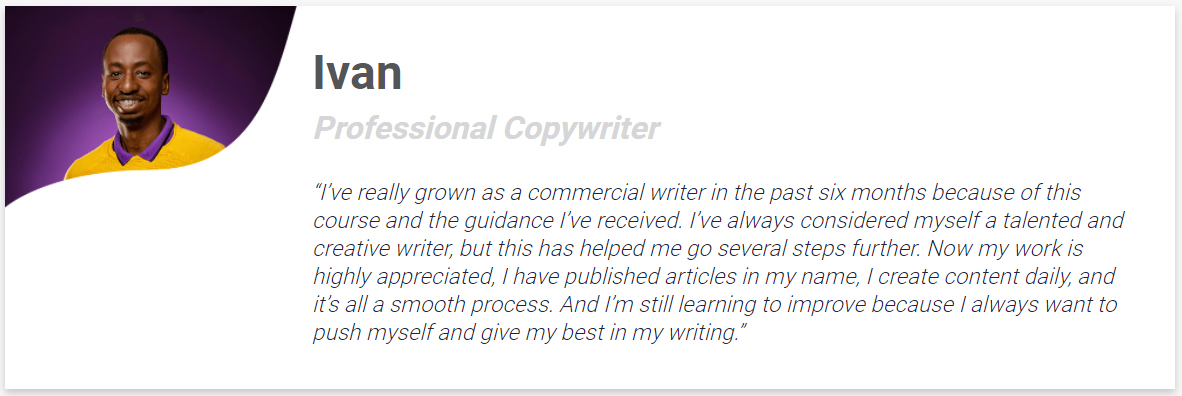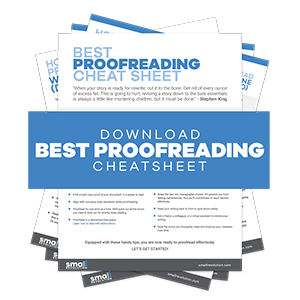There can’t be great copywriting without creativity.
Creative copywriting is only possible when a true love story exists between creativity and the copywriter.
Copywriting is often associated with marketing. Yet marketing keeps changing at the speed of light.
With this reality, you can’t sacrifice creativity for boring, mass-produced content. If you did, you’d get lost in the mad rush of consumers, search engines, and corporations who are all yearning for something different.
Today, over 2.5 quintillion bytes of data are created daily, with millions of pieces of content shared. There isn’t any sign of this trend slowing down any time soon.
That’s why there’s only one way that brands, copywriters, and marketers can get noticed—creativity.
As a copywriter, you want to do more than just recycle ideas and scrape content. To rise to the top of your career, you must be creative in all aspects of your work—from visuals to the actual copy. You can’t climb this ladder without creativity.
If you write bland content, your readers will get bored and leave. You won’t stay afloat on the content marketing sea if you sacrifice creativity in the name of keeping traditions.
That’s just how important creativity is in copywriting. What next for writers?
Just like everything else, even a creative person with unique ideas might suffer fatigue.
We highlight the three fundamentals of creative copywriting.
Fundamental #1: Identify the Story in Every Campaign
As a copywriter, you must identify the story in every marketing campaign.
It doesn’t matter whether you’re helping a start-up build its web content or writing ad copy for an already established multinational corporation; you must identify the story within the campaign.
The story is what keeps creativity alive. Luckily, there are many ways to do this.
If you’re writing copy for a company, try putting yourself in its shoes. Is it passionate about what it does? How do its products make its target customers’ world a better place?
If it doesn’t appear clearly, put yourself in the client’s shoes. How will the service or product help them enjoy their life more? What will draw them to the company?
Every campaign has a story. As a copywriter, it’s your role to draw this out. However, you need to be creative while at it.
As a copywriter, how do you identify and tell the story in your marketing campaign? Here are a few tips.
Tip 1: Make Your Audience the Hero
Any good story must start with a great cast. It must also have a clear hero. Yet your story’s hero isn’t you. Neither is it the business. Today’s audience will find such kinds of stories uninspiring and egotistical.
The real hero of your story should be the customer. As a copywriter, you must make your story about them. Even better, tell their stories.
Tip 2: Use Imagery
It doesn’t matter whether you’re creating an all-out ad or writing a blog post. Imagery is crucial for any creative copywriter.
You can show striking imagery through interesting infographics or superb graphic design. You can also write it right into your copy.

Tip 3: Present a Villain
You won’t find a great story without an obstacle that stands in the way of success. What’s this insurmountable hurdle preventing your audience from realizing their goals?
Your job as a creative copywriter is to provide your audience with the tools they’ll need to slay the dragon.
Tip 4: Evoke Emotion
Your audience wants stories that can connect with real human beings. Such stories evoke emotion, bring people together and inspire them to feel something powerful.
Tip 5: Bring in a Happy Ending
Your stories must be about how your audience can overcome their problems and realize their goals. You must show them how they can use your clients’ services or products to achieve their goals.
You can add character development and depth to your story by considering your audience’s dreams as a fundamental transformation. Just how does your laid-out solution transform your audience? How is your story inspiring?
Fundamental #2: Write Compelling Copy
The aim of copywriting is to sell. As such, your headlines and the rest of the content must be compelling and captivating.
Compelling copy will entice your audience. That way, they’ll stay engaged with your message and follow your call to action (CTA).
Before you begin writing, whether a blog article, a direct mail, or rewriting a landing page, here are 4 tips to help you write compelling copy.
Tip 1: Understand Your Target Audience
The first thing you should do before you begin to write is to define your target audience. Why?
You can only know your audience’s problems if you know who they are. It becomes easier to provide an identifiable solution if you’re aware of the issues.
In addition, when you clearly understand your target audience, you can quickly get valuable insights into their lives, including:
- Spending habits
- Job positions at work
- Shopping preferences
With these insights, you can amass invaluable information that can help you build a buyer profile. From this point, you want to make sure you meet the following:
- Provide the right solutions at the best price
- Write in a style and tone that resonates well with your audience
- Address concerns and answer the key questions that they may have
- Use the right messaging to get your audience over the line
Tip 2: Use Emotional and Personal Copy
There is a big difference between that piece of content that readers skip over and that which makes them take action. It’s all about how you write the article.
Content is personal, persuasive, and emotive. The reader should feel as though it was written specifically for them.
It should address their particular pain points and highlight the benefits that are appealing to them.
By the time the reader is done reading your content, they connect with that strong emotion. It’s this emotion that will convince them to take the next step.
Is it fear or excitement and enthusiasm that will prompt them to take the next step?
As a creative copywriter, you want to play with your audience’s desires. Focus more on the benefits they stand to receive and less on features.
Tip 3: Create Urgency and Scarcity
With your strong writing and clear position, you’ve managed to elicit some emotion from your audience. Now it’s time to take advantage of this momentum. You need to create a sense of urgency and scarcity that your readers can’t ignore.
With tons of stimulating material everywhere, you need to find a clever way to persuade your readers to take action. Urgency and scarcity is an excellent way to achieve this.
You can utilize personalized marketing technology to help you create deadlines for individuals.
Tip 4: Conclude with a Strong Call-to-Action
You need to tailor your CTA to your reader’s specific needs.
However, it depends on where your target audience is in the marketing funnel. If they’re in the ‘consideration’ or ‘interest’ stage of the funnel, a soft CTA works better than a straight ‘Buy Now’ CTA.
Fundamental #3: Don’t Edit as You Write
As a creative copywriter, you can boost your creativity significantly if you stop editing while you write. Instead, get your thoughts out first; you can tidy them up later.
To stay creative, you need to write freely and fast. Therefore, you should never rewrite or correct until you’re done. Why?
You unleash your creativity.
In contrast, you stifle creativity if you have to stop writing to self-edit or rewrite. In addition, it will interfere with rhythm and flow that only comes from an unconscious association with the material.
Creative versus Critical: Which Way for Creative Copywriters?
Your writing is likely to slow down when you keep stopping to edit because your brain treats editing and writing as two different tasks. When you switch between editing and writing modes, you also switch between your brain’s critical and creative sides.
On the other hand, you create flow when you write first and edit later. With this flow, you write freely because your mind is completely immersed. How can you stop the habit of self-editing as you write? Here’s how.
| Tip | How it helps |
| Schedule a specific time for free writing. | It trains your creative juices. |
| Go offline before you start writing. | It ensures you don’t hop onto the internet when you hit a snag. |
| Set a timer and only stop writing when it sounds. | It helps dump your brain’s content onto paper. |
| Start with a clean document. | It ensures you’re not distracted by previous work. |
| Create an outline and flesh it out. | It helps organize your thoughts. |
| Avoid looking at what you’ve written until it’s over or even the next day. | It helps avoid stifling creativity. |
Becoming Successful Creative Copywriter: What Next?
Understanding the fundamentals of creative copywriting comes with tremendous benefits.
The best product in the world isn’t worth much if you can’t sell it. Excellent copy will help you convince your prospects to buy your product without sounding too pushy. How do you go about it?
You need to learn the tools and skills that will make you that creative copywriter.
The SEO Copywriting Course by Small Revolution is all you need to learn the skills, techniques, and tools you need to master SEO copywriting. The course has helped many copywriters succeed in their careers.
Meet Ivan, a professional copywriter who attributes his success to this course.
 You could be part of this success story too. Enroll today.
You could be part of this success story too. Enroll today.


